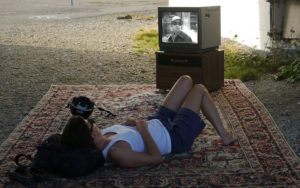Versuch einer Gegenüberstellung von historischen und aktuellen Stadtraumfragen [Attempt on a confrontation of historic and current questions about urban space]

During this festival held in the ruins of a soccer stadium in Zurich, a living room comes into being in the entrance corridor of the former stadium. In this living room, an old television screens historic video interviews made in the 1980s on the streets of the Swiss German cities of Zurich, Basel, and Bern. During the interviews, passers-by comment on squatted houses of these times – sometimes in a positive manner, sometimes hostile. The interviews are part of a documentary produced at that time by the squatters themselves and come from Swiss Social Archives in Zurich.

